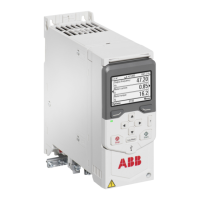■ Separate control cable ducts
Put 24 V DC and 230 V AC (120 V AC) control cables in separate ducts, unless the 24 V DC
cable is insulated for 230 V AC (120 V AC) or insulated with an insulation sleeving for
230 V AC (120 V AC).
24 V DC
230 V AC
(120 V AC)
230 V AC
(120 V AC)
24 V DC
Implementing short-circuit and thermal overload protection
■ Protecting the drive and input power cable in short-circuits
Use the fuses specified in the technical data. Make sure that the electric power supply
network meets the specification (minimum allowed short-circuit current for the fuses).
The fuses restrict drive damage and prevent damage to adjoining equipment in case of a
short-circuit inside the drive. When located at the distribution board, the fuses also protect
the input power cable against short circuits.
See the technical data for alternative short-circuit protections.
■ Protecting the motor and motor cable in short-circuits
The drive protects the motor cable and motor in a short-circuit situation when the motor
cable is sized according to the nominal current of the drive. No additional protection devices
are needed.
■ Protecting the drive, and the input power and motor cables against
thermal overload
If the cables have the correct size for the nominal current, the drive protects itself and the
input and motor cables against thermal overload. No additional thermal protection devices
are needed.
WARNING!
If the drive is connected to multiple motors, use a separate motor thermal overload
device for protecting each motor cable and motor against overload. The drive
overload protection is for the sum of the total motor load. It may not trip due to an
overload in one motor.
■ Protecting the motor against thermal overload
According to regulations, the motor must be protected against thermal overload and the
current must be switched off when overload is detected. The drive includes a motor thermal
Guidelines for planning the electrical installation 47

